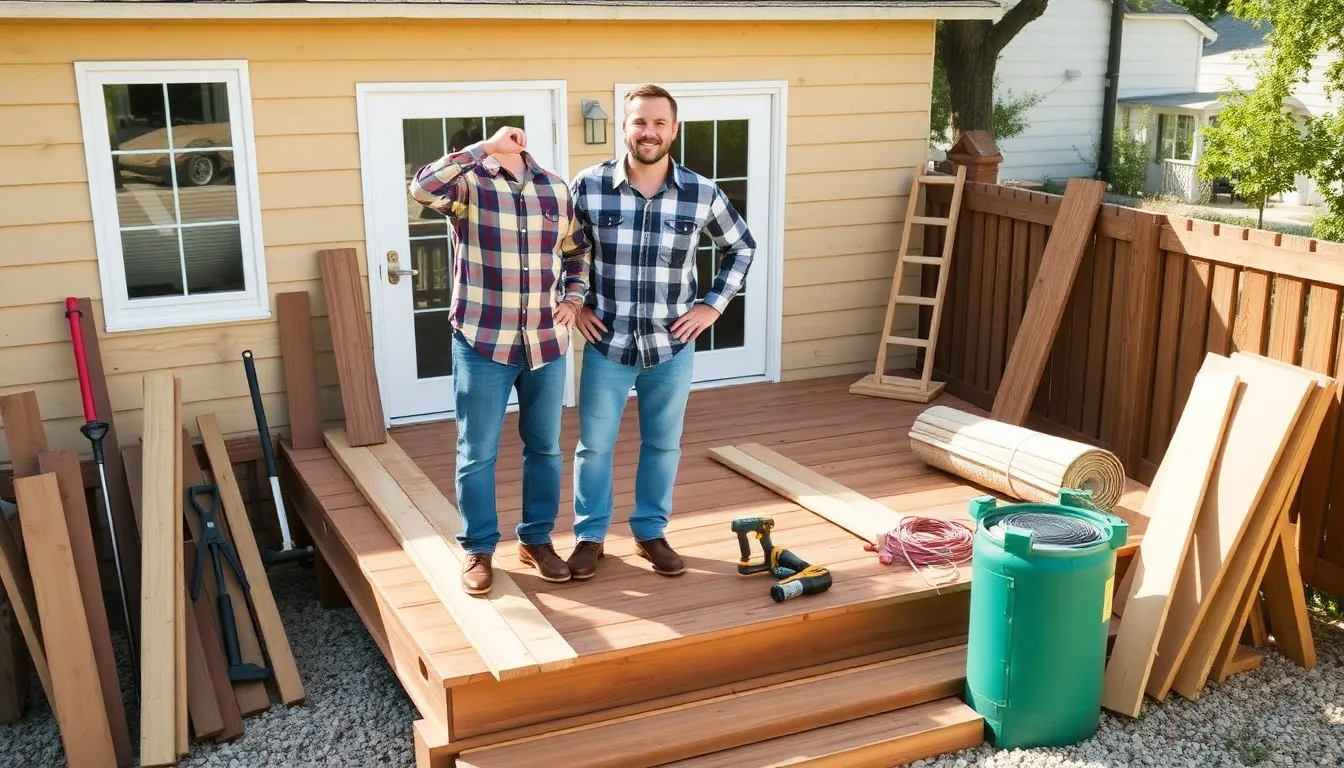Building a DIY deck is like crafting your own slice of paradise right in your backyard. Imagine sipping your morning coffee while basking in the sun, or hosting epic barbecues under the stars. It’s not just a project; it’s a ticket to outdoor bliss. Plus, who wouldn’t want to impress friends with a deck that screams, “I’m a home improvement guru!”?
Table of Contents
ToggleWhat Is a DIY Deck?
A DIY deck refers to a deck built by an individual without professional assistance. This outdoor structure serves multiple purposes, enhancing both home aesthetics and functionality. People often use DIY decks for relaxation, outdoor dining, and social gatherings.
Constructing a deck involves choosing materials like wood, composite, or PVC, each offering unique benefits. Wood provides a classic look with natural warmth, while composites offer lower maintenance and durability. Adequate planning contributes to a successful project, including selecting the right size and layout for the available space.
Building a DIY deck also encourages creativity, allowing individuals to design a space suited to their personal style. Incorporating features such as railings, seating, and built-in planters adds character and utility. To improve safety and longevity, proper construction techniques are essential, including using quality fasteners and ensuring even support.
Cost savings represent another advantage of building a DIY deck. Typically, labor costs form a significant portion of professional builds. Individuals can minimize expenses by conducting the project themselves while still achieving a professional appearance.
Resources for DIY deck projects abound, including online tutorials, design software, and local hardware stores. Community forums or workshops provide additional guidance and support for those embarking on DIY endeavors. Ultimately, a DIY deck transforms an outdoor area into an inviting retreat, reflecting personal tastes and enhancing lifestyle enjoyment.
Benefits of Building a DIY Deck

Building a DIY deck offers significant advantages, including cost savings and customization opportunities. These benefits make the project appealing to many homeowners.
Cost Savings
Cost savings represent a primary benefit of building a DIY deck. Individuals can eliminate labor costs, which often account for a large portion of deck expenses. Choosing materials wisely also helps reduce overall spending; for instance, opting for pressure-treated lumber instead of premium options can make a big difference. In addition, those who source materials during sales or use reclaimed wood can further cut costs. The final result presents an attractive appearance without the hefty price tag associated with hiring professionals.
Customization Opportunities
Customization opportunities define the DIY deck experience. Homeowners can design their space according to personal preferences, modifying the dimensions, layout, and materials to suit specific needs. Integrating features like built-in seating, unique railings, or even lighting options adds a personal touch. Moreover, individuals can choose colors and finishes that harmonize with their home’s exterior, creating a cohesive look. This level of personalization ensures the deck serves as a true reflection of their style and enhances outdoor enjoyment.
Essential Tools and Materials Needed
Building a DIY deck requires specific tools and materials to ensure a successful project. Knowing what to gather ahead of time saves effort and time.
Tools for Building
Basic tools include a drill for making pilot holes and fastening screws. A level ensures the deck remains even, while a saw cuts materials to the desired lengths. Measuring tape and square aid in accurate measurements and layout. A hammer helps in driving nails, while safety gear, like gloves and goggles, protects against injuries. Each tool plays a vital role in the construction process.
Materials Selection
Choosing the right materials impacts durability and aesthetics. Pressure-treated wood offers resistance to insects and decay, making it a popular choice. Composite boards require lower maintenance than traditional wood and resist fading. PVC decking provides moisture resistance and comes in various colors, allowing for design versatility. Notably, reclaimed wood can add character while being eco-friendly. Selecting materials based on local climate and intended use ensures long-lasting results.
Step-by-Step Guide to Building Your DIY Deck
Building a DIY deck requires careful planning and execution. Follow these steps for a successful project.
Planning and Design
Start by deciding the size and shape of the deck. Consider local regulations regarding deck dimensions and height. Sketch a layout that incorporates desired features, such as built-in seating or planters. Select materials based on your design and personal style, ensuring they fit your budget. Visit home improvement stores for inspiration and material options. Finalize the design before moving to the next step.
Preparing the Site
Clear the chosen location of debris, grass, and obstacles. Mark the perimeter using stakes and string for precise measurements. Ensure the ground is level by using a transit level or measuring tape. Drainage is important, so consider sloping the ground away from the house. If necessary, excavate to create a solid, stable base. Compacted gravel can provide additional stability.
Constructing the Frame
Begin frame construction with pressure-treated lumber for durability. Cut the beams to size based on your design. Secure the beams in place using a level to ensure even support. Add joists at regular intervals according to your deck plan. Ensure proper spacing for decking boards, typically 16 inches on center. Use galvanized screws to resist corrosion and extend the lifespan of the frame.
Laying the Decking
Place decking boards perpendicular to the joists for maximum support. Leave small gaps between boards to allow for water drainage and expansion. Cut boards to fit around corners and edges accurately. Secure each board with screws, ensuring a tight fit. Sand rough edges with a sander for a smooth finish. Treat the deck with a sealant for protection against weather elements.
Maintenance Tips for Your DIY Deck
Keeping a DIY deck in top condition requires regular attention and care. Routine maintenance ensures longevity and enhances outdoor enjoyment.
Regular Cleaning
Cleaning involves removing dirt, leaves, and debris from the deck surface. A broom or leaf blower works well for this task, and it’s important to clean every couple of weeks. Using a mild detergent mixed with water can remove stains without damaging the deck material. Soft bristle brushes help tackle stubborn spots effectively. After scrubbing, rinse thoroughly with a hose to prevent soap residue. This simple routine prevents mold and mildew growth, preserving the deck’s appearance and structural integrity.
Seasonal Care
Inspecting the deck each season is crucial for maintaining its condition. In spring, check for signs of wear from winter weather, focusing on loose boards or nails. Summer calls for a reapplication of sealant to protect the wood from UV rays. When fall arrives, clear fallen leaves promptly to avoid moisture retention. Winter maintenance involves covering the deck or using protective mats to prevent ice damage. Implementing seasonal care helps sustain the lifespan of the deck while keeping it safe and aesthetically pleasing.
Building a DIY deck is more than just a home improvement project; it’s an opportunity for personal expression and outdoor enjoyment. With careful planning and the right materials, anyone can create a stunning space that enhances their backyard. The satisfaction of crafting a unique deck tailored to individual tastes can transform outdoor living experiences.
Regular maintenance ensures that the deck remains beautiful and functional for years to come. By embracing this DIY journey, homeowners can enjoy a welcoming retreat that serves as a backdrop for cherished memories with family and friends. The possibilities are endless, and the rewards are well worth the effort.






